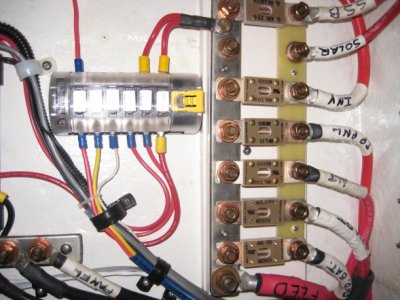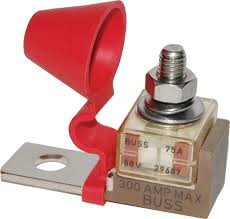Duncancw
Member
Hi,
My boat currently has a 90Watt solar system that provides power to the house battery. It's great for keeping the battery topped up in winter when she is ashore and during the summer it does keep my 12v fridge running most of the day (in sunny conditions). It's great for day sailing and the weekends but not great if we want to use the boat for an extended period as it doesn't generate enough power.
I've recently purchased an additional 200watts of solar (2x100watt panels in serial). I've installed the panels and ran the cables to a new Victron SCC (100/20). The bit I'm having problems with the connection between the new SCC and the house battery. The existing system is getting very messy and there are already 5 connections on the positive side of the house battery. I really like to find a better solution for this. The other problem is that the existing SCC is using the main posts on that 6 way circuit fuse panel, i.e only allowing me to use one circuit and thus I can't connect the new SCC to the fuse panel.
I've attached a diagram to illustrate my scenario. The new components in the gold box are what I've install but I've not attached them to anything yet. (I haven't actually wired the new solar panels into the SCC but the cables are in situ).
Should I get rid of the 6 way fuse box and install a Victron fused distribution board or is that overkill? or could I just install a positive busbar or can I make use of the 6 way fuse box?
Any advise before I proceed any further would be greatly appreciated.
My boat currently has a 90Watt solar system that provides power to the house battery. It's great for keeping the battery topped up in winter when she is ashore and during the summer it does keep my 12v fridge running most of the day (in sunny conditions). It's great for day sailing and the weekends but not great if we want to use the boat for an extended period as it doesn't generate enough power.
I've recently purchased an additional 200watts of solar (2x100watt panels in serial). I've installed the panels and ran the cables to a new Victron SCC (100/20). The bit I'm having problems with the connection between the new SCC and the house battery. The existing system is getting very messy and there are already 5 connections on the positive side of the house battery. I really like to find a better solution for this. The other problem is that the existing SCC is using the main posts on that 6 way circuit fuse panel, i.e only allowing me to use one circuit and thus I can't connect the new SCC to the fuse panel.
I've attached a diagram to illustrate my scenario. The new components in the gold box are what I've install but I've not attached them to anything yet. (I haven't actually wired the new solar panels into the SCC but the cables are in situ).
Should I get rid of the 6 way fuse box and install a Victron fused distribution board or is that overkill? or could I just install a positive busbar or can I make use of the 6 way fuse box?
Any advise before I proceed any further would be greatly appreciated.


